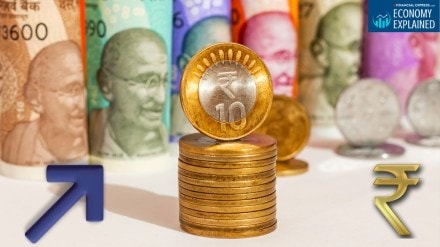The Indian rupee has been on a slippery slope this year – losing around 3.1% against the US Dollar in 2025 up until October 28, 2025. This has occurred at a time when US dollar itself has weakened against all major currencies. Thus, the INR has lost a lot more against most other currencies. For instance, the INR has lost around 15% against the Euro, 9% against the British Pound and around 6% against the Japanese Yen.
Why India’s strong fundamentals aren’t helping
A declining rupee can be seen as an indication of a weaker economy. However, India’s macro fundamentals remain sound – GDP expanded 7.8% in the April–June quarter and expected to hold around 6.5% for the full year, inflation is trending well below the RBI’s 4% target and Current account deficit at about 1% of GDP.
Add to this an impressive $700 billion in foreign exchange reserves — enough to cover 11 months of imports — and a modest external debt load of below 19% of GDP. Clearly, the rupee’s fall isn’t because of an economic weakness.
The real culprit: A capital outflow problem
The answer lies not in fundamentals, but in how global money is moving and how investors are feeling right now.
India attracts a significant amount of foreign investment thanks to its robust economic growth. Typically, the capital account surplus ranges from 2% to 2.5% of GDP each year. However, this figure saw a substantial decline in 2025. As per the figures available until June 30, 2025, the net capital inflow for the year amounts to only USD 2.25 billion, representing merely 0.1% of GDP.
The main factor behind this decline is a sharp drop in foreign equity capital inflows, which encompass both foreign direct investment (FDI) and foreign portfolio investment (FPI). The net FDI inflows have been lacklustre for the last three years – falling from the highs of USD 40-45 billion annual figures between FY20-22 to just USD 1 billion in FY25.
Foreign portfolio investors have also turned net sellers in the Indian stock markets, pulling out around USD 16 billion from the start of 2025 until October 27, 2025.
Due to their inherently volatile nature, capital flows often overshadow fundamentals in the short run, which has been a significant factor contributing to the depreciation of the INR in 2025.
Global tensions and trade headwinds
Geopolitical uncertainties and trade tensions have also influenced the investors’ sentiment. Amidst president trump’s reset of trade relations, it was anticipated that India would be granted favourable treatment by the United States. Contrary to expectations, India is facing one of the highest tariffs at 50%.
Additionally, modifications to H1B visa regulations and the proposed HIRE Act could have a significant impact on India’s trade relationship with the US. Strained relations with the US have undermined market confidence and may have played a role in the depreciation of the INR.
Why the RBI is staying on the sidelines
Amidst all this, the Reserve Bank of India (RBI) hasn’t rushed to defend the rupee – allowing market forces to play out. Between April and August, the RBI’s foreign exchange interventions (purchase and sale) averaged about USD11 billion a month, far below the monthly average of USD 63 billion in FY25.
Having said that, the RBI has a sizeable USD 700 billion of foreign exchange reserves. This enables it to intervene to defend INR against any potential exogenous shock.
A necessary correction: The valuation catch-up
For years, the rupee held up better than most other emerging-market currencies. It didn’t fall as much as others, partly because global investors trusted India’s growth story. But that made it look a little too expensive compared to its peers.
Now, the currency seems to be correcting that. The 40- currency Real Effective Exchange Rate (REER) — a measure that compares the rupee with its major trading partners — shows the rupee is now actually undervalued by about 4%.
In simple terms, it means the rupee may have fallen a bit more than it needed to, but that also means it could stabilise or even recover once things calm down globally.
The bottom line
The rupee’s slide this year is not a verdict on India’s economy — it’s a reflection of a challenging global environment. India’s economic fundamentals remain solid, and the central bank has enough firepower to keep volatility in check.
Overall, INR’s movements should be more gradual going ahead provided trade dispute with the US is settled.
Data Source – Bloomberg, RBI
Pankaj Pathak is Fund Manager for Fixed Income at UTI AMC.
Disclaimer
The views expressed are author’s own views and not necessarily those of UTI Asset Management Company Limited. The views are not an investment advice and investors should obtain their own independent advice before taking a decision to invest in any asset class or instruments.
Mutual Fund Investments are subject to market risks, read all scheme related documents carefully.
